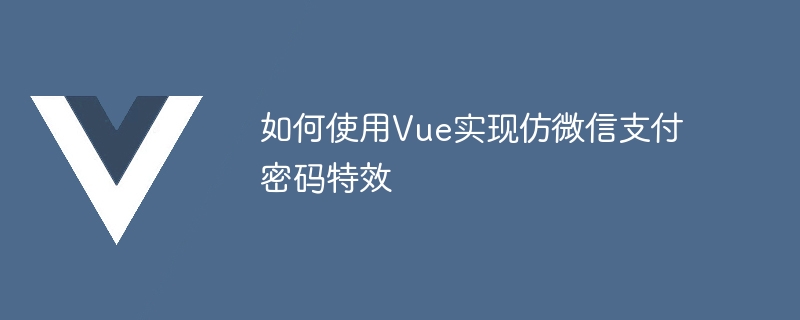

How to use Vue to implement imitation WeChat payment password effects
The WeChat payment password effect is a common payment password input method. Each digit of the password is entered through a digital circle. Gradually lighting up, as well as animation effects such as the color change of the circle after the password is entered, provide users with an interactive and friendly payment experience. In this article, we will use the Vue framework to implement this WeChat payment password-like effect and provide specific code examples.
First, we need to create a project using Vue. You can use the Vue CLI to quickly create a new Vue project. The specific steps are as follows:
npm install -g @vue/cli
vue create wechat-payment
cd wechat-payment
npm run serve
After completing the above steps, our Vue project has been successfully created.
Next, we need to create a password input component. In Vue, components are reusable blocks of code used to build user interfaces. In this example, we will create a component named PasswordInput to implement WeChat payment password-like effects. The specific code is as follows:
<template>
<div class="password-input">
<div class="circle" v-for="(input, index) in inputs" :key="index"
:class="{ active: index < password.length }"></div>
</div>
</template>
<script>
export default {
data() {
return {
password: '',
inputs: [1, 2, 3, 4, 5, 6], // 密码位数
};
},
};
</script>
<style scoped>
.password-input {
display: flex;
justify-content: space-between;
}
.circle {
width: 16px;
height: 16px;
border-radius: 50%;
border: 1px solid #ccc;
}
.active {
background-color: #333;
}
</style>In the above code, we define a PasswordInput component, which contains a loop statement to dynamically add style classes based on the length of the currently entered password active, to achieve the effect of the circle gradually lighting up.
Next, we need to use the PasswordInput component in the main application. Open the App.vue file and add the following code to the template:
<template>
<div id="app">
<PasswordInput></PasswordInput>
</div>
</template>
<script>
import PasswordInput from './components/PasswordInput.vue';
export default {
name: 'App',
components: {
PasswordInput,
},
};
</script>
<style>
#app {
display: flex;
justify-content: center;
align-items: center;
height: 100vh;
background-color: #f5f5f5;
}
</style>In the above code, we introduced the PasswordInput component and used it in the template .
So far, we have completed the Vue implementation of WeChat payment password effects.
In order to verify whether our code is valid, we can start the Vue development server and preview the effect through the browser. Enter the following command on the command line to start the Vue development server:
npm run serve
Then, open the browser and visit http://localhost:8080 to preview the WeChat payment password special effects .
Through the above steps, we successfully used the Vue framework to implement imitation WeChat payment password effects and provided specific code examples. You can further customize and optimize according to actual needs to achieve more interactive effects.
The above is the detailed content of How to use Vue to implement imitation WeChat payment password effects. For more information, please follow other related articles on the PHP Chinese website!